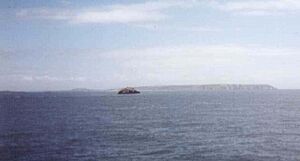Ortac facts for kids
Ortac is a small, empty island (called an islet) located about 5 kilometers (3 miles) west of Alderney, one of the Channel Islands. It's close to another islet called Burhou. Ortac is quite small, measuring about 50 by 70 meters (160 by 230 feet).
Some people believe the name "Ortac" comes from the Norman language. A.H. Ewen suggests it means "large rock at the edge." Long ago, the French used to call it "the Eagle's Nest."
Contents
Geology: The Rock's Story
Ortac, Alderney, and the Casquets rocks are all part of the same long sandstone ridge. Imagine them as connected underwater by a hidden rocky path!
A famous artist from Guernsey, Paul Naftel, once drew Ortac. This drawing was featured in a book called The Channel Islands (1862). The authors of the book wrote about how these islands are connected: If the sea level were about 37 meters (120 feet) lower, Alderney, Burhou, Ortac, and the Casquets would all be joined together by low land. They would form one long island, about 19 kilometers (12 miles) long!
Another old book from 1906, The Channel Pilot, warned sailors about the area: "Between Ortac, Verte Tête, and Burhou Island, there are many dangerous rocks and ledges. The ocean currents here move very fast!"
Ortac is also said to have a hidden cave, which people call "The Oven."
Victor Hugo and the Mysterious Rock
Victor Hugo, a famous French writer who lived on Guernsey, wrote a lot about the Channel Islands. In his novel, The Laughing Man, he described Ortac as a powerful and scary rock:
"...on the left side of the ship, a tall, dark, straight mass appeared from the mist. It was the Ortac rock. Ortac stands eighty feet tall above the crashing waves... It's a solid cliff that goes straight down into the many twisting parts of the sea. At night, it looks like a huge block resting on a giant black sheet. During a storm, it waits for the powerful hit of thunder...
To crash on the Casquets is to be torn apart; to hit Ortac is to be crushed into powder... On a straight face like Ortac's, waves or cannonballs can't bounce off... if a wave carries a ship onto the rock, the ship breaks and is lost...
In another one of his books, The Toilers of the Sea, Hugo shared a strange story about Ortac. He mentioned that people used to believe Saint Malo lived on the rock:
The fishermen from Normandy who sail in the Channel have to be careful because of strange things Satan makes them see. For a long time, people believed that Saint Maclou lived on the big square rock called Ortac, between Alderney and the Casquets. Many old sailors said they often saw him there, sitting and reading a book. So, as sailors passed by, they would often kneel before the Ortac rock. But then, the story changed, and the truth came out. It was discovered that the lonely person living on the rock was not a saint, but a devil! This evil spirit, named Jochmus, pretended to be Saint Maclou for many centuries.
Wildlife: Home to Gannets
Ortac is famous for its very large colony of gannets, which are big seabirds. This colony is actually quite new! On June 19, 1940, a man named Major J.A.A. Wallace visited Ortac to check on the kittiwake birds. He only found one gannet there. He didn't find any on Les Etacs near Alderney either. But now, both places are full of these birds!
In 1979, two navy helicopters were sent to Ortac. Their mission was to remove old fishing nets and trash that the gannets were using in their nests, which could trap them.
Airway R41: A Path in the Sky
Romeo 41 (R41) is like a highway in the sky, called an Airway. It goes over the English Channel, connecting the Channel Islands to the Solent area in England. There's a special spot on this airway called a reporting point named ORTAC. This point is where Romeo 41 meets the Channel Islands Control Zone.
The ORTAC reporting point is located about 30 miles north-north-east of Alderney. It's important to know that this sky-point is not exactly above the Ortac islet, but its name definitely comes from the islet!
Many flight paths for planes flying into and out of the Channel Islands airports use ORTAC as part of their route. For example, if an Aurigny airline flight is going from Alderney to Southampton, the pilot might hear: "Ayline 123: your clearance is to the Northern Zone boundary via ORTAC, on track Romeo 41."
- Channel Islets - Victor Coysh
- Alderney Tower at Alderney Airport, on 125.350 MHz.
Images for kids
-
Ortac seen from above Clonque Bay, Alderney






